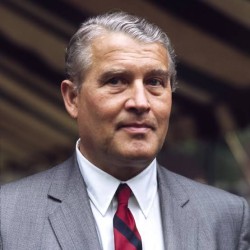
Wernher von Braun
| Date of Birth | : | 23 Mar, 1912 |
| Date of Death | : | 16 Jun, 1977 |
| Place of Birth | : | Wyrzysk, Poland |
| Profession | : | Rocket Scientist, Writer, Physicist, Architect |
| Nationality | : | American, German |
Wernher Magnus Maximilian Freiherr von Braun was a German-American aerospace engineer and space architect. He was a member of the Nazi Party and the Allgemeine SS, a leading figure in the development of rocket technology in Nazi Germany, and later a pioneer of rocket and space technology in the United States.
Early life
Wernher von Braun was born on 23 March 1912, in the small town of Wirsitz in the Province of Posen, Kingdom of Prussia, then German Empire and now Poland.
His father, Magnus Freiherr von Braun (1878–1972), was a civil servant and conservative politician; he served as Minister of Agriculture in the federal government during the Weimar Republic. His mother, Emmy von Quistorp (1886–1959), traced her ancestry through both parents to medieval European royalty and was a descendant of Philip III of France, Valdemar I of Denmark, Robert III of Scotland, and Edward III of England. He had an older brother, the West German diplomat Sigismund von Braun, who served as Secretary of State in the Foreign Office in the 1970s, and a younger brother, Magnus von Braun, who was a rocket scientist and later a senior executive with Chrysler.
Career in Germany
In 1930, von Braun attended a presentation given by Auguste Piccard. After the talk, the young student approached the famous pioneer of high-altitude balloon flight, and stated to him: "You know, I plan on traveling to the Moon at some time." Piccard is said to have responded with encouraging words.
Von Braun was greatly influenced by Oberth, of whom he said:
Hermann Oberth was the first who, when thinking about the possibility of spaceships, grabbed a slide-rule and presented mathematically analyzed concepts and designs... I, myself, owe to him not only the guiding-star of my life, but also my first contact with the theoretical and practical aspects of rocketry and space travel. A place of honor should be reserved in the history of science and technology for his ground-breaking contributions in the field of astronautics.
Engineering philosophy
Von Braun's insistence on more tests after Mercury-Redstone 2 flew higher than planned has been identified as contributing to the Soviet Union's success in launching the first human in space. The successful Mercury-Redstone BD flight took the launch slot that might have put Alan Shepard into space, three weeks ahead of Yuri Gagarin. His Soviet counterpart Sergei Korolev insisted on two successful flights with dogs before risking Gagarin's life on a crewed attempt. The second test flight took place one day after the Mercury-Redstone BD mission.
Personal life
Von Braun had a charismatic personality and was known as a ladies' man. As a student in Berlin, he often was seen in the evenings in the company of two girlfriends at once. 63 He later had a succession of affairs within the secretarial and computer pool at Peenemünde. 92–94
In January 1943, von Braun became engaged to Dorothee Brill, a physical education teacher in Berlin, and he sought permission to marry from the SS Race and Settlement Main Office. However, the engagement was broken due to his mother's opposition.146–147 Later in 1943, he had an affair with a French woman while in Paris preparing V-2 launch sites in northeastern France. She was imprisoned for collaboration after the war and became destitute.
Death
In 1973, von Braun was diagnosed with kidney cancer during a routine medical examination. However, he continued to work unrestrained for a number of years. In January 1977, then very ill, he resigned from Fairchild Industries. Later in 1977, President Gerald R. Ford awarded him the country's highest science honor, the National Medal of Science in Engineering. He was, however, too ill to attend the White House ceremony.
